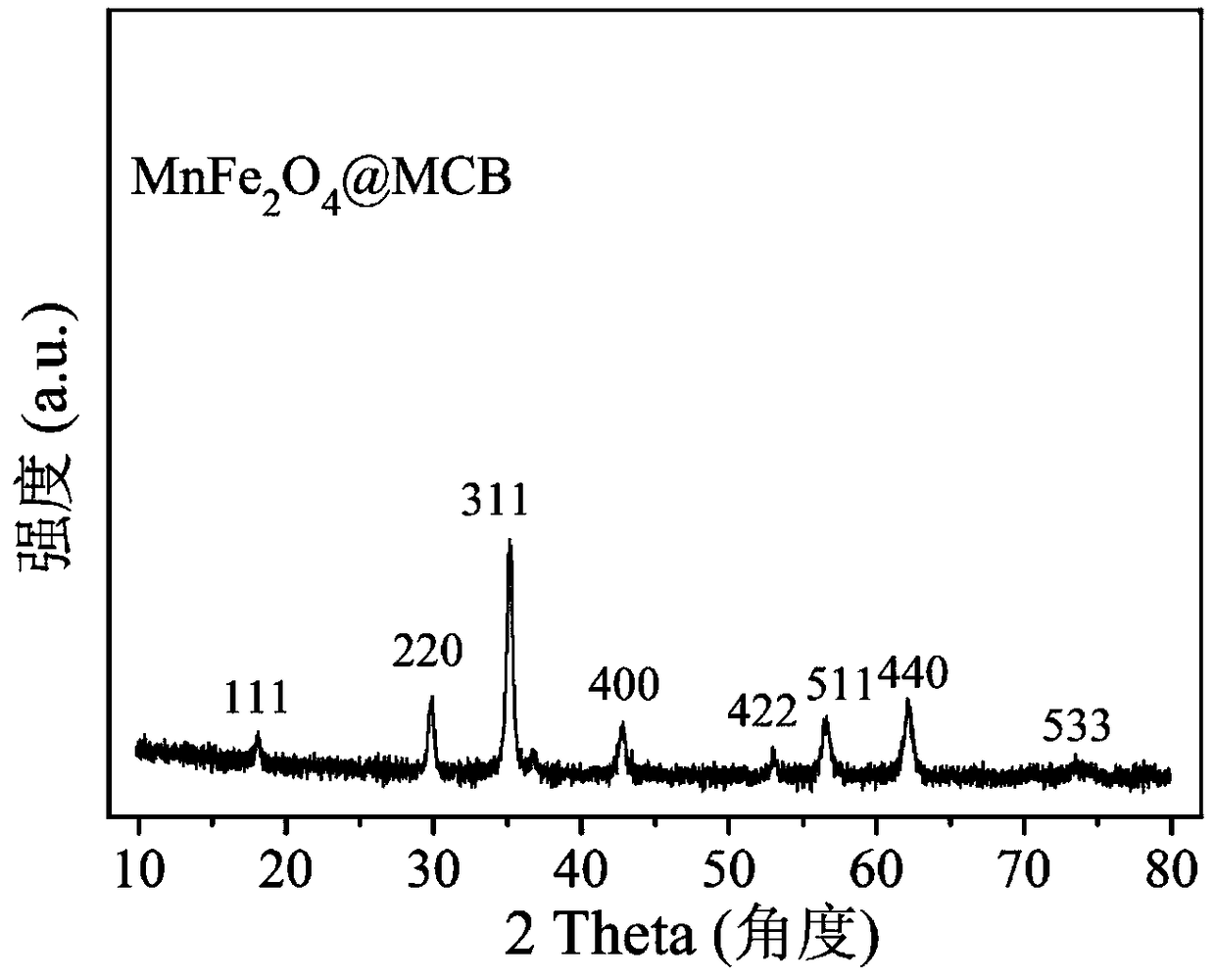Magnetic ferromanganese oxide-loaded mesoporous cellulose biochar composite, and preparation method and application thereof
A technology of ferromanganese oxides and composite materials, applied in the fields of alkali metal oxides/hydroxides, chemical instruments and methods, alkali metal compounds, etc., to achieve the effects of low price, easy operation, and high magnetic saturation
- Summary
- Abstract
- Description
- Claims
- Application Information
AI Technical Summary
Problems solved by technology
Method used
Image
Examples
Embodiment 1
[0064] Embodiment 1: the preparation of a kind of mesoporous cellulose biochar (MCB)
[0065] The cellulose was placed in a tube furnace, and the temperature was raised to 300 °C at a heating rate of 5 °C / min. 2 Carbonize under airflow for 60 minutes to obtain cellulose charcoal (CB); mix the above cellulose charcoal with potassium hydroxide at a mass ratio of 1:3, and then add water to it to keep the lye concentration of 30wt%. The above solution was dried in an oven at 80°C to obtain cellulose biochar-potassium hydroxide (CB-KOH); the above-mentioned cellulose biochar-alkali was placed in a tube furnace at a heating rate of 5°C / min heating up to 700°C, under continuous N 2 The cellulose biochar (CB-700) was obtained by incubating under air flow for 60 minutes. After cooling, it was washed with water until neutral, and dried in vacuum at 30° C. for 12 hours to obtain mesoporous cellulose biochar (MCB-700).
Embodiment 2
[0066] Embodiment 2: the preparation of a kind of mesoporous cellulose biochar (MCB)
[0067] The cellulose was placed in a tube furnace, and the temperature was raised to 250 °C at a heating rate of 3 °C / min. 2 Carbonize under airflow for 80 minutes to obtain cellulose charcoal (CB); mix the above cellulose charcoal with potassium hydroxide at a mass ratio of 1:2, and then add water to it to keep the lye concentration of 20wt%. The above solution was dried in an oven at 70°C to obtain cellulose biochar-potassium hydroxide (CB-KOH); the above-mentioned cellulose biochar-alkali was placed in a tube furnace at a heating rate of 3°C / min heated up to 550°C under continuous N 2 The cellulose biochar (CB-550) was obtained by incubating under airflow for 240 minutes. After cooling, it was washed with water until neutral, and dried in vacuum at 20°C for 24 hours to obtain mesoporous cellulose biochar (MCB-550).
Embodiment 3
[0068] Embodiment 3: the preparation of a kind of mesoporous cellulose biochar (MCB)
[0069] The cellulose was placed in a tube furnace, and the temperature was raised to 350 °C at a rate of 8 °C / min. 2 Carbonize under airflow for 40 minutes to obtain cellulose charcoal (CB); mix the above cellulose charcoal with potassium hydroxide at a mass ratio of 1:4, and then add water to it to maintain a lye concentration of 40wt%. The above solution was dried in an oven at 90°C to obtain cellulose biochar-potassium hydroxide (CB-KOH); the above-mentioned cellulose biochar-alkali was placed in a tube furnace at a heating rate of 8°C / min heated up to 850°C under continuous N 2 The cellulose biochar (CAC-850) was obtained by incubating under air flow for 30 minutes. After cooling, it was washed with water until neutral, and dried in vacuum at 40°C for 6 hours to obtain mesoporous cellulose biochar (MCB-850).
PUM
| Property | Measurement | Unit |
|---|---|---|
| specific surface area | aaaaa | aaaaa |
| adsorption capacity | aaaaa | aaaaa |
Abstract
Description
Claims
Application Information
 Login to View More
Login to View More - R&D
- Intellectual Property
- Life Sciences
- Materials
- Tech Scout
- Unparalleled Data Quality
- Higher Quality Content
- 60% Fewer Hallucinations
Browse by: Latest US Patents, China's latest patents, Technical Efficacy Thesaurus, Application Domain, Technology Topic, Popular Technical Reports.
© 2025 PatSnap. All rights reserved.Legal|Privacy policy|Modern Slavery Act Transparency Statement|Sitemap|About US| Contact US: help@patsnap.com



